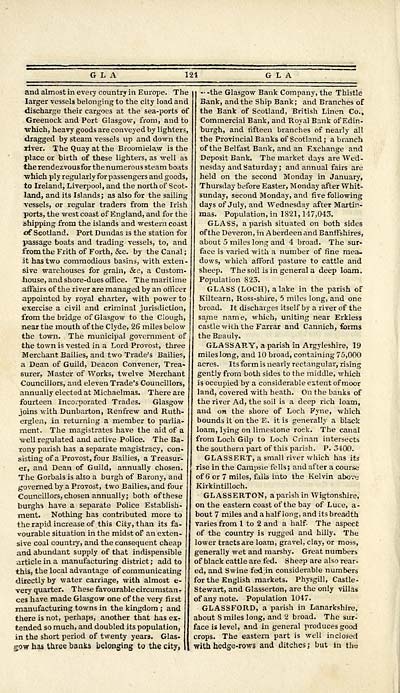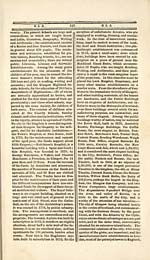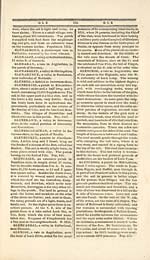Gazetteer of Scotland
(126) Page 124
Download files
Complete book:
Individual page:
Thumbnail gallery: Grid view | List view

and almost in every country in Europe. The
larger vessels belonging to the city load and
discharge their cargoes at the sea-ports of
Greenock and Port Glasgow, from, and to
which, heavy goods are conveyed by lighters,
dragged by steam vessels up and down the
liver. The Quay at the Broomielaw is the
place or birth of these lighters, as well as
the rendezvousforthenumerous steam boats
which ply regularly for passengers and goods,
to Ireland, Liverpool, and the north of Scot-
land, and its Islands; as also for the sailing
vessels, or regular traders from the Irish
ports, the west coast of England, and for the
shipping from the islands and western coast
of Scotland. Port Dundac is the station for
passage boats and trading vessels, to, and
from the Frith of Forth, &c. by the Canal ;
it has two commodious basins, with exten-
sive warehouses for grain, &c, a Custom,
house, and shore-dues office. The maritime
affairs of the river are managed by an officer
appointed by royal charter, with power to
exercise a civil and criminal jurisdiction,
from the bridge of Glasgow to the Clough,
near the mouth of the Clyde, 26 miles below
the town. The municipal government of
the town is vested in a Lord Provost, three
Merchant Bailies, and two Trade's Bailies,
a Dean of Guild, Deacon Convener, Trea-
surer, Master of Works, twelve Merchant
Councillors, and eleven Trade's Councillors,
annually elected at Michaelmas. There are
fourteen Incorporated Trades. Glasgow
joins with Dunbarton, Renfrew and Ruth-
erglen, in returning a member to parlia-
ment. The magistrates have the aid of a
well regulated and active Police. The Ba-
rony parish has a separate magistracy, con-
sisting of a Provost, four Bailies, a Treasur-
er, and Dean of Guild, annually chosen.
The Gorbals is also a burgh of Barony, and
governed by a Provost, two Bailies, and four
Councillors, chosen annually; both of these
burghs have a separate Police Establish-
ment. Nothing has contributed more to
the rapid increase of this City, than its fa-
vourable situation in the midst of an exten-
sive coal country, and the consequent cheap
and abundant supply of that indispensible
article in a manufacturing district ; add to
this, the local advantage of communicating
directly by water carriage, with almost e-
very quarter. These favourablecircumstanr
ces have made Glasgow one of the very first
manufacturing towns in the kingdom ; and
there is not, perhaps, another that has ex-
tended so much, and doubled its population,
in the short period of twenty years. Glas-
gow has three banks belonging to the city,
i G L A
- -the Glasgow Bank Company, the Thistle
Bank, and the Ship Bank; and Branches of
the Bank of Scotland, British Linen Co.,
Commercial Bank, and Royal Bank of Edin-
burgh, and fifteen branches of nearly all
the Provincial Banks of Scotland ; a branch
of the Belfast Bank, and an Exchange and
Deposit Bank. The market days are Wed-
nesday and Saturday ; and annual fairs are
held on the second Monday in January,
Thursday before Easter, Monday after Whit-
sunday, second Monday, and five following
days of July, and Wednesday after Martin-
mas. Population, in 1821,147,045.
GLASS, a parish situated on both sides
ofthe Deveron, in Aberdeen and Banffshires,
about 5 miles long and 4 broad. The sur-
face is varied with a number of fine mea-
dows, which afford pasture to cattle and
sheep. The soil is in general a deep loam.
Population 823.
GLASS (LOCH), a lake in the parish of
Kiltearn, Ross-shire, 5 miles long, and one
broad. It discharges itself by a river of the
same name, which, uniting near Erkless
castle with the Farrar and Cannich, forms
the Bsauly.
GLASS ARY, a parish in Argyleshire, 19
miles long, and 10 broad, containing 75,000
acres. Its form is nearly rectangular, rising
gently from both sides to the middle, which
is occupied by a considerable extent of moor
land, covered with heath. On the banks of
the river Ad, the soil is a deep rich loam,
and ob the shore of Loch Fyne, which
bounds it on the E. it is generally a black
loam, lying on limestone rock. The canal
from Loch Gilp to Loch Crinan intersects
the southern part of this parish. P. 5400.
GLASSERT, a small river which has its
rise in the Campsie fells; and after a course
of 6 or 7 miles, falls into the Kelvin above
Kirkintilloch.
GLASSERTON, a parish in Wigtonshire,
on the eastern coast of the bay of Luce, a-
bout 7 miles and a half long, and its breadth
varies from 1 to 2 and a half- The aspect
of the country is rugged and hilly. The
lower tracts are loam, gravel, clay, or moss,
generally wet and marshy. Great numbers
of black cattle are fed. Sheep are also rear-
ed, and Swine fed;in considerable numbers
for the English markets. Physgill, Castle-
Stewart, and Glasserton, are the only villas
of any note. Population 1047.
GLASSFORD, a parish in Lanarkshire,
about S miles long, and 2 broad. The sur-
face is level, and in general produces good
crops. The eastern part is well inclosed
with hedge-rows and ditches; but in the
larger vessels belonging to the city load and
discharge their cargoes at the sea-ports of
Greenock and Port Glasgow, from, and to
which, heavy goods are conveyed by lighters,
dragged by steam vessels up and down the
liver. The Quay at the Broomielaw is the
place or birth of these lighters, as well as
the rendezvousforthenumerous steam boats
which ply regularly for passengers and goods,
to Ireland, Liverpool, and the north of Scot-
land, and its Islands; as also for the sailing
vessels, or regular traders from the Irish
ports, the west coast of England, and for the
shipping from the islands and western coast
of Scotland. Port Dundac is the station for
passage boats and trading vessels, to, and
from the Frith of Forth, &c. by the Canal ;
it has two commodious basins, with exten-
sive warehouses for grain, &c, a Custom,
house, and shore-dues office. The maritime
affairs of the river are managed by an officer
appointed by royal charter, with power to
exercise a civil and criminal jurisdiction,
from the bridge of Glasgow to the Clough,
near the mouth of the Clyde, 26 miles below
the town. The municipal government of
the town is vested in a Lord Provost, three
Merchant Bailies, and two Trade's Bailies,
a Dean of Guild, Deacon Convener, Trea-
surer, Master of Works, twelve Merchant
Councillors, and eleven Trade's Councillors,
annually elected at Michaelmas. There are
fourteen Incorporated Trades. Glasgow
joins with Dunbarton, Renfrew and Ruth-
erglen, in returning a member to parlia-
ment. The magistrates have the aid of a
well regulated and active Police. The Ba-
rony parish has a separate magistracy, con-
sisting of a Provost, four Bailies, a Treasur-
er, and Dean of Guild, annually chosen.
The Gorbals is also a burgh of Barony, and
governed by a Provost, two Bailies, and four
Councillors, chosen annually; both of these
burghs have a separate Police Establish-
ment. Nothing has contributed more to
the rapid increase of this City, than its fa-
vourable situation in the midst of an exten-
sive coal country, and the consequent cheap
and abundant supply of that indispensible
article in a manufacturing district ; add to
this, the local advantage of communicating
directly by water carriage, with almost e-
very quarter. These favourablecircumstanr
ces have made Glasgow one of the very first
manufacturing towns in the kingdom ; and
there is not, perhaps, another that has ex-
tended so much, and doubled its population,
in the short period of twenty years. Glas-
gow has three banks belonging to the city,
i G L A
- -the Glasgow Bank Company, the Thistle
Bank, and the Ship Bank; and Branches of
the Bank of Scotland, British Linen Co.,
Commercial Bank, and Royal Bank of Edin-
burgh, and fifteen branches of nearly all
the Provincial Banks of Scotland ; a branch
of the Belfast Bank, and an Exchange and
Deposit Bank. The market days are Wed-
nesday and Saturday ; and annual fairs are
held on the second Monday in January,
Thursday before Easter, Monday after Whit-
sunday, second Monday, and five following
days of July, and Wednesday after Martin-
mas. Population, in 1821,147,045.
GLASS, a parish situated on both sides
ofthe Deveron, in Aberdeen and Banffshires,
about 5 miles long and 4 broad. The sur-
face is varied with a number of fine mea-
dows, which afford pasture to cattle and
sheep. The soil is in general a deep loam.
Population 823.
GLASS (LOCH), a lake in the parish of
Kiltearn, Ross-shire, 5 miles long, and one
broad. It discharges itself by a river of the
same name, which, uniting near Erkless
castle with the Farrar and Cannich, forms
the Bsauly.
GLASS ARY, a parish in Argyleshire, 19
miles long, and 10 broad, containing 75,000
acres. Its form is nearly rectangular, rising
gently from both sides to the middle, which
is occupied by a considerable extent of moor
land, covered with heath. On the banks of
the river Ad, the soil is a deep rich loam,
and ob the shore of Loch Fyne, which
bounds it on the E. it is generally a black
loam, lying on limestone rock. The canal
from Loch Gilp to Loch Crinan intersects
the southern part of this parish. P. 5400.
GLASSERT, a small river which has its
rise in the Campsie fells; and after a course
of 6 or 7 miles, falls into the Kelvin above
Kirkintilloch.
GLASSERTON, a parish in Wigtonshire,
on the eastern coast of the bay of Luce, a-
bout 7 miles and a half long, and its breadth
varies from 1 to 2 and a half- The aspect
of the country is rugged and hilly. The
lower tracts are loam, gravel, clay, or moss,
generally wet and marshy. Great numbers
of black cattle are fed. Sheep are also rear-
ed, and Swine fed;in considerable numbers
for the English markets. Physgill, Castle-
Stewart, and Glasserton, are the only villas
of any note. Population 1047.
GLASSFORD, a parish in Lanarkshire,
about S miles long, and 2 broad. The sur-
face is level, and in general produces good
crops. The eastern part is well inclosed
with hedge-rows and ditches; but in the
Set display mode to: Large image | Transcription
Images and transcriptions on this page, including medium image downloads, may be used under the Creative Commons Attribution 4.0 International Licence unless otherwise stated. ![]()
| Gazetteers of Scotland, 1803-1901 > Gazetteer of Scotland > (126) Page 124 |
|---|
| Permanent URL | https://digital.nls.uk/97423206 |
|---|

